Polish sausages, charcuterie and the blood sausage
Since ancient times roasted, stewed or fried meat is by far the dominant component in Polish cuisine and Polish food traditions. Most people cannot imagine a breakfast without even a slice of fragrant and juicy ham, and the fame of Polish sausage has reached many countries in the entire world. Since the Old Polish days, sausages and hams, in fact all Polish charcuterie (in Polish: wędliny), was hosted on the tables of noble, bourgeois, and peasant. The food was consumed more or less depending on the financial status.
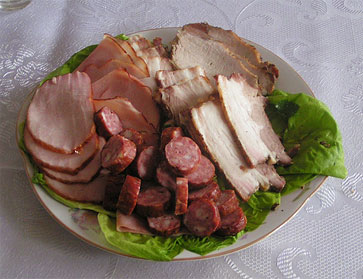
Making Polish coldcuts (wędliny) and sausages (kiełbasy)
Basic traditional methods of production of Polish hams and sausages were based on drying: hanging under the roof until mature, and then smoked in the natural smoke. For example in Podlasie region (Podlachia) and north-eastern borderlands, traditional 'kindziuk' was made this way. Kindziuk is a very aromatic, dry, but fleshy sausage with an addition of pepper and garlic. Kindziuk is also a traditional food in Lithuania.
In the past meat stuffing of all Polish sausages was always put in a natural casing like intestines or stomach membranes, and of course nobody used any chemicals. A lot of spices and herbs did the work perfectly. Industrial monosodium glutamate would be an offence. Times change however, and now there's a noticeable difference in prices of traditionally made coldcuts (wędliny) and sausages (kiełbasy), versus these coming from mass production and inundating shelves in supermarkets. Up to this day one of Polish food specialties, which is produced exclusively according to traditional Polish recipes is a raw sausage. It is preserved with salt only, then smoked and dried. However, when you visit Poland and want to try some traditional and natural coldcut of sausage direct your steps towards small groceries rather than markets under Tesco, Auchan or Carrefour signs. There are also traditional food fairs organized regularly in all Polish cities, when you can buy natural products which are trustworthy models of Polish taste. The prices are higher than in supermarkets of course, but the quality is worth it.
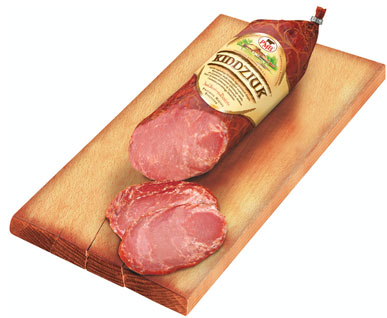
Nowadays three basic processes in the production of meats and sausages are: salting, curing and smoking.
Curing is a very important and necessary one because, after salting the meat takes on a gray color. Curing is a method to prevent it, and for years it's made by treating meat with salt, saltpeter, nitrite, sugar and polyphosphates, all in an aqueous solution called brine. There's also a method based on so-called 'dry curing mixture', nevertheless in both cases meat recovers its pink-red color and additionally becomes more long-lasting. Pork and beef meat are the most popular meat types usually subjected to curing. The process affects ennobling their taste.
Smoking is the final step in the production of sausages, and traditionally it occurs in a curing chamber filled with a smoke of a hardwood. Smoking is in fact saturation of meat with ingredients of a wood smoke. Due to high temperature substantial amount of water is removed from meat. Smoked meat changes its color, taste and smell. A crust is formed on the surface and this dry cover prolongs inner meat juiciness. During the process meat protein structure is changed in a way similar to cooking. In consequence smoked and dried meat is suitable for consumption without any further processing.
There's a lot of companies in Poland, which produce tasty and usually healthy hams and sausages, both according to traditional recipes and methods, as well as new ones. You have a wide range of choices between meat products in Polish groceries. Now, let's have a look at the most specific and popular.
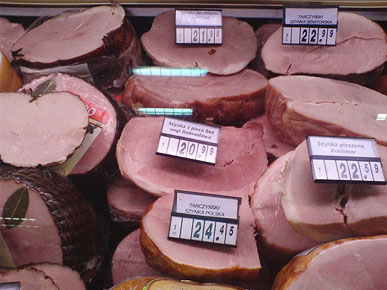
in "sklep miesny" (meat shop). Photo by ikeX
Polish charcuterie – polskie wędliny
Polędwica sopocka is a steamed and smoked high quality pork meat (boned). It has a brown peel and after cutting it into slices one can see a nice and pink meat, without any grease visible. Addition of natural spices enhances the flavor and aroma reminiscent of traditional smoked pork. The ham is perfect for salads and sandwiches with light-brown bread.
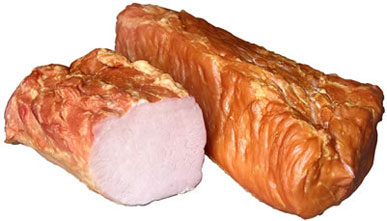
Szynka babuni is a traditional ham, made from a large piece of pork. This ham is popular since First World War and since then evolved over the years. However, still the whole process is based on old recipes. Therefore, it retains its unique flavour and appearance. It is big and rounded, and has a diameter of about 20 cm. Extra taste is provided by a bit of fat on the edge, which should be removed when you maintain a light diet.
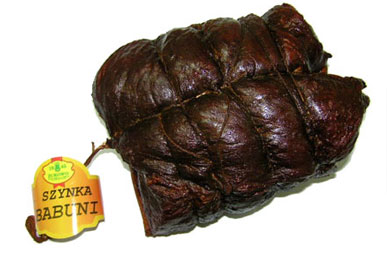
Another Polish food delicacy is a loin of pork, which can be prepared in many ways. What we have in shops is usually a choice between two most popular varieties: roasted loin of pork (in Polish: schab pieczony) or a smoked one (schab wędzony). Roasted pork is characterized by a golden crust and light meat, quite often with the addition of dried plums, apricots or raisins inside. This is something I can frankly recommend you to try.
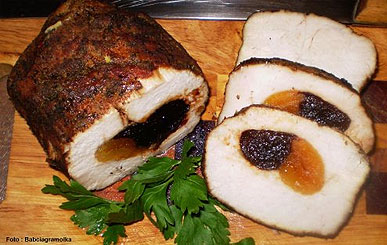
Photo by babciagramolka
Smoked loin of pork has a brown skin and a more pronounced flavor. The hallmark of this product is that schab wędzony is made with no additives, and is much more juicy than the roasted one. In some Polish families preparation of home-made loin of pork, according to their own wishes and appreciation, remains a popular tradition. Therefore, you can buy 1.5 - 2 kg raw pork cuts in most Polish meat shops. These are ready to be roasted in the home, with preferred additions and various fillings.
Polish sausages — polskie kiełbasy
Of course, we should not forget about famous Polish sausages. Most of sausages in Poland are sold as on of two basic types: normal/raw or smoked/dry. The dry ones have the advantage of lasting longer, while still retaining the full flavor. Usually dry Polish sausages are consumed cold, while normal/raw ones can be eaten both cold or after cooking, frying or baking. Sausages are a great speciality of Polish cuisine and there are dozen of varieties. Majority of them is based on pork meat, however. In some areas beef, and sometimes turkey, horse, lamb, or bison sausages are also available as regional specialties. Each region has its own ones – read more about regional Polish food here).
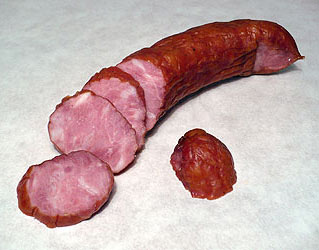
Parówki, better known in English as Vienna sausages, are much more delicate than typical Polish sausages, and more subtle in flavor. These are made from many types of meats, however, the most popular are chicken, pork and veal meat. They are very liked and popular among children. Cooked parówki are often served for breakfast, and eaten with white bread, mustard or ketchup. On the other hand many Poles perceive parówki as a low quality, unhealthy food. Usually there's a large fat content and the method of production, which is based on grinding meat and fat down, leaves a place for adding some repulsive ingredients, including chemical additives, which are obviously unnoticeable in the final product.
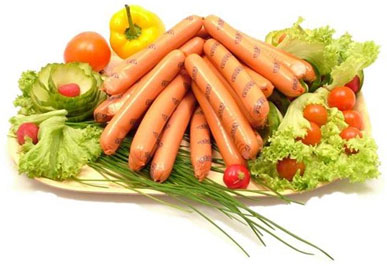
Hence, I would not recommend you trying Polish parówki, also because it is not a very traditional Polish specialty. You thould rather try another great Polish food, called kabanosy (singular form is "kabanos"). These are thin, long, usually dried & smoked sausages. What you can see on a picture below is an example of quite tasty Polish brakefast: kabanosy and twarozek made of Polish curd cheese:
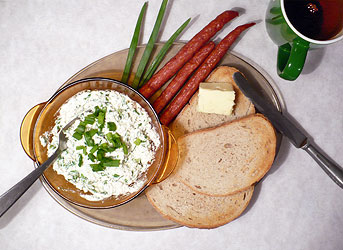
served with toasted white bread and black tea
Polish blood sausage — kaszanka aka kiszka
Another specialty in the Polish food collection is the blood sausage – kaszanka / kiszka in Polish – made of a mixture of pig's blood, pig offal (commonly liver, lungs, skin, and fat) and buckwheat (sometimes barley or rice). All of these ingredients are stuffed in a pig intestine. Dark, bloody stuffing is flavored with onion, black pepper and marjoram.
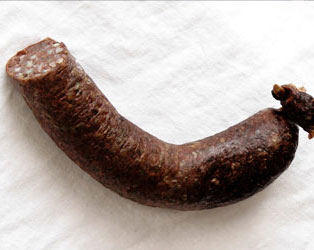
In the past kaszanka was made in Polish homes on a doubtfully pleasant occasion of killing a pig, when fresh blood was available. Today there are as many enthusiasts of blood sausage, as these who despise this allegedly plebeian food. Well, there is nothing to hide – kaszanka has always been a by-product of a pig slaughter. That's the recipe: half of the pig head, skin and meat scraps have to be cooked over low heat with some spices - bay leaf and allspice. You should let it cook until tender. Then chopped pieces of liver are added fifteen minutes before the end of cooking. Mix buckwheat and barley, than pour broth over it and cook until they absorb the bouillon. Mix all the ingredients in a bowl. Add cooled barley, 1.5 liter of pig's blood, and spices. The resulting mass, which should not be too watery is used to fill intestines membrane. Then cooked in water for about twenty minutes.
In the history of Polish cuisine, the most faithful of blood sausage were people from Upper Silesia region. The mixture of meat residues with barley and blood, seasoned properly, was however eaten not more than two times a year. And it was not because of a tradition of any kind, but because of the fact, that in the distant past, the blood sausage belonged to the exceptional delicacies.
Nowadays blood sausage is available in all Polish meat stores and can be eaten after cooking, or frying. In summer times kaszanka, as well as any kind of raw Polish sausages, are very popular food during Polish-style grilling. Serve it with bread, sauces like mustard or ketchup and some vegetables, including pickles, stand few bottles of Polish beer on the table, and everyone will be happy.